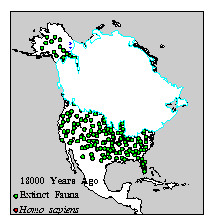The Late Pleistocene Extinctions
Approximately 11,000 years ago a variety of animals went extinct across North America. These were mostly mammals larger than approximately 44 kg (about 100 pounds). Some of the animals that went extinct are well known (like saber-toothed cats, mammoths, and mastodons). Others were less well known animals (like the short-faced skunk and the giant beaver). Some animals went extinct in North America but survived elsewhere, for example, horses and tapirs.
Before this extinction the diversity of large mammals in North America was similar to that of modern Africa. As a result of the extinction, relatively few large mammals are now found in North America.
Why did these animals go extinct?
The real answer is that scientists do not know for sure. This is an active area of research for several paleontologists at the ISM and for many scientists at other institutions.
Scientists who study the extinction have identified three major mechanisms that may have caused the extinction. These three causes are
Human Hunting

The animated figure to the left shows a simplified example of how the spread of humans could have interacted with the distribution of now extinct animals.
Just after 14,000 years ago human migrants from Asia entered the New World. They may have been the first people to set foot in North America. They are known as the Clovis people. Their sites and artifacts, including distinctive projectile points, are found over much of North America.
These people hunted and gathered wild animals and plants. The animals they hunted included many that became extinct. However, they also hunted numerous animals that survived.
Many scientists think that these people caused the extinction in North America at the end of the Pleistocene. Researchers who support this view generally favor one of two explanations. The first is that human over-hunting directly caused the extinction. The second is that over-hunting eliminated a "keystone species" (usually the mammoths or mastodon) and this led to environmental collapse and a more general extinction.
Environmental Causes Related to Climate Change

Between about 18,000 and 11,500 years ago the climate and environments of North America were changing rapidly. Temperatures were warming. Rainfall patterns were changing. The glaciers were melting. The seasonal difference in temperatures was increasing.
These climate changes were causing fundamental changes in the ecosystems of North America. Plants and animals were moving out of areas they had lived in and into new areas. Communities were coming apart and reorganizing.
Many scientists think that these climatic and ecosystem changes caused the extinctions at the end of the Pleistocene. The environmental changes might have caused extinction by eliminating food sources, disrupting birth schedules, or exposing animals to climatic conditions to which they were not adapted.
Hyperdisease
The third hypothesis to account for large scale extinctions at the end of the Pleistocene is based on the idea of hyperdiseases, which are highly infectious diseases.
This theory was most recently proposed by Dr. Ross MacPhee of the American Museum of Natural History and Dr. Preston Marx of the Aaron Diamond AIDS Research Center. It supposes that as human populations expanded into new areas during the Pleistocene, for example, into North America approximately 14,000 years ago, they brought with them one or more disease-causing agents. These diseases, new to the New World, jumped from human or animal carriers (for example, their dogs) to the highly susceptible large native fauna. These diseases, according to this theory, were sufficieintly lethal to wipe out the native animals.
Almost all scientists working on this problem agree that the extinction was caused by one of these two mechanisms or by some combination of them.
For more information on this hypothesis, as well as on the researchers studying it and the tools they use to investigate the theory, one can examine the American Museum Internet Biobulletin: What Killed the Mammoths?
Where Else Did These Extinctions Occur?
North America is not the only continent which experienced an extinction of this kind near the end of the Pleistocene. In South America most of the species of medium to large mammals also went extinct approximately 11,500 years ago.
In Australia a major extinction also occurred. The timing of this extinction is much more poorly known; however, it appears to date to between 40,000 and 24,000 years ago.
Europe, Asia, and Africa also experienced some extinction toward the end of the Pleistocene. However, on all of these continents the extinction was less severe (fewer species involved).